Youth Hockey – Sticks, pucks and lots of fun
(Written: July 2009)
It’s a sight that can be found at ice rinks all over the world: pint-sized hockey players gliding en masse toward the same net. The kids skate at different speeds, many going just a short distance before they fall, seemingly in slow motion, to the ice. And it doesn’t matter where the first player falls, you can bet that others will follow suit. I remember watching this scene unfold during the first intermission of every University of Alabama Huntsville home game when I was a student there. My friends and I would wait until the kids had played before rushing to the snack bar.
There’s something about the sight of a 5 year old half-skating, half-wobbling on the vast rink that brings out tenderness in almost everyone who attends a hockey game. It’s such a stark contrast to the much older players who speed up the ice with skill, deliver crushing hits and maneuver the puck with almost blinding quickness. We forget, as we watch the bruisers, that once upon a time THEY were the little tykes trying to balance on skates wearing what felt like a ton of bulky equipment and trying to shovel a hard rubber disk along a slippery, icy surface with a stick.
But that’s exactly how every single player you’ve ever cheered or booed started out. Gordie Howe wobbled on skates. Bob Probert probably fell quite a lot before he learned to be good with his feet– and his fists. Sidney Crosby had to work on his hand-eye coordination. Alexander Ovechkin had to learn to stay upright, before learning to launch himself into the boards. In fact, I think only Wayne Gretzky and Mario Lemieux were actually born knowing how to skate and handle the puck as amazingly as they did (I’m kidding. Well, sorta).
No, every hockey player at every level of the game began his or her career at a very young age, usually with a local skating club or team. Crosby played in the Timbits program in his hometown in Nova Scotia. Gretzky played in Brantford, Ontario. Former Seattle Thunderbird Captain (current Manchester Monarch) Thomas Hickey played with Trails West Hockey Association in Calgary. His teammate, Bud Holloway (currently with the Ontario Reign) played near his hometown of Wapella, Saskatchewan. Former T-Bird (current Toronto Marlie) Greg Scott grew up playing youth hockey in Victoria, BC, alongside former Everett Silvertip (and current Manitoba Moose) D-man Taylor Ellington. I could go on but you get the picture.
I spoke with several people about the benefits of playing youth hockey. Not everyone I spoke with went on to pursue a pro hockey career. But everyone agrees, hitting the ice young helped them develop more than great skating and puck handling skills. It helped them develop determination, concentration and dedication, skills that are crucial to navigating a much tougher game called “Life.”
Everett Silvertips Right Wing Shane Harper grew up playing hockey in what would once have been thought a very unlikely place: Southern California. But that was before the Edmonton Oilers turned the NHL on its head by trading “The Great One”, Wayne Gretzky, to the Los Angeles Kings in 1988; the stunning trade following ten years of stellar play in Edmonton, including four Stanley Cups.
Once Gretzky donned the (then) black and silver of the LA Kings, hockey exploded in Southern California. But even then, there weren’t that many leagues for kids. Harper lives in Valencia (in the San Fernando Valley). He began his hockey career at age 5 on roller blades, playing in a roller hockey league at his neighborhood YMCA. He enjoyed it so much, his parents enrolled him in the West Valley Wolves ice hockey league the next year, putting him on a collision course with “The Great One” himself.
“I loved playing roller hockey so my parents decided to sign me up for ice hockey,” Shane remembers. “That’s (the league was) where the Kings practiced, in Van Nuys. I played, actually, with Gretzky’s son and daughter. They were on my team, just by chance.”
Shane not only played on a team with Gretzky’s children, they also came to his 7th birthday party, along with their famous dad. To this day, Shane considers that one of the high points of his life. (Who wouldn’t!)
As Shane grew older and his skills improved, he joined higher-level teams filled with players of the same skill set. This team practiced in Orange County, and traveled a lot, which made for some grueling drives. But Shane’s parents were always there to make the trip, sometimes leaving work early to make sure he made it to practice on time.
“We would have to drive an hour on a good day and with traffic, sometimes two hours down to Orange County from Valencia and that’s rough right after school, doing my homework in the car, driving down and practicing for an hour, an hour and a half and then driving back and going to sleep and then doing it again. We usually practiced 2 to 3 times during the school week and then weekends we had games.”
Picture going to school all day, then jumping in the car for a trek, in rush hour, to hockey practice, doing homework or wolfing your dinner in the back seat. But Shane says his commute was nothing, compared to some of his teammates’. “I remember not wanting to do any homework just because I was so tired. It was really tough but a lot of the guys on my team did it as well. There were some guys that commuted from San Jose all the way down to Orange County. They’d fly down on the weekends.”
When Shane was 13, he joined the prestigious “California Wave” youth hockey team. (The Wave merged with LA’s other top-notch youth team, the Junior Kings, to form one powerhouse program). The Wave traveled all over the US and Canada, winning many tournaments. There’s even a documentary chronicling the team’s winning reputation (“In the Crease”/Stickmen Pictures). And it’s not just lip service. In 2005, the year he joined the Everett Silvertips, 7 of his teammates were also selected by WHL teams.
“It’s almost unheard of from a California team turning out 7 top notch WHL players. I know my old coach is pretty proud and California hockey is just going up right now,” says Shane.
Along with a winning reputation comes coaches who are tough, sometimes maybe a little too tough on 13 and 14 year olds who are still trying to develop emotionally, even as their physical skills skyrocket. Shane concedes that Wave coach Jack Bowkus was tough behind the bench, but a different person off the ice.
“He’s a very hard-nosed guy on the ice. He gets what he wants and he’s gonna let you know if you’re not bringing it. But off the ice, he’s a great guy and that’s how coaches are and that’s how they should be.”
Shane Harper/Photo: Frank Deines III/Everett Silvertips
Shane just wrapped up his second year with the Silvertips. He had a great season, scoring 32 goals and 34 assists in 72 games for 66 points. He and the ‘Tips advanced to the first round of the WHL playoffs, where they lost in 5 games to the Tri-City Americans. When I caught up with him, he was home in Valencia, but not sitting idle. Shane trains at a local gym in the off-season, hits the rink, and also hits the driveway for games of road hockey with his friends. It’s a way for him to hang out with his buddies, but much more than that.
“It’s a lot of fun and it keeps you wanting to play but also at the same time, you don’t even realize you’re getting better. You’re improving your hand-eye coordination, you’re improving your stick-handling skills, you’re better while practicing out in the driveway just having fun with your friends.”
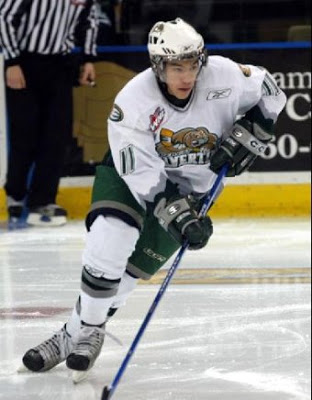 Shane Harper/Photo: Frank Deines III/Everett Silvertips
Shane Harper/Photo: Frank Deines III/Everett Silvertips
When Shane joined the ‘Tips, he had no idea he would run into someone else who had benefitted from the same youth hockey league that helped hone his early skills. Jon Rosen, the team’s Director of Broadcasting and Public Relations, also cut his teeth as part of the West Valley Wolves organization in the San Fernando Valley. The hockey bug bit Jon at a young age.
“I was 5 years old when my dad first took me to a game (during the 1986-87 season). It was a Kings/Canucks game, in the Marcel Dionne years with the Kings wearing their purple and gold jerseys. It was just an amazing night that I will never forget. The Kings lost 5-3 to the Canucks and there’s been a lot of losing ever since. But ever since that first game, I’ve been a huge fan.”
Jon watched Kings games but didn’t learn to skate until he was about 7 or 8 years old. He joined the West Valley program until he was a little older. Jon says the rigors that come with practicing and playing the game, helped him develop in other areas as a child.
“It gave me good tenacity and good commitment because we would regularly have practice times at 4 or 5 in the morning. So we would have to get up at 3am and schlep all the way out to the middle of the Valley. Once I was able to do that, all other extra-curricular (activities) became easy and fun.”
Jon says the teams he played with were recreational. But by no means, were they easy. He remembers what happened when, as a 13 year old, he moved up into a mixed Bantam/Midget league.
“There were not enough players in the midget league that year so they combined bantam and Midget. I was the youngest Bantam player (13 – 17 years old). That year, I had the crap beat out of me. It was a full-on contact, full-hitting league and I was the youngest and one of the smallest players there and every game I would go out and just get leveled, get destroyed, get the wind knocked out of me and repeatedly thrashed. I never scored any goals and as like a 4th line guy but it felt like the most important thing to me at that time.”
Jon’s team went on to win the championship game that year against a team that included some of his friends. He says that rough year at age 13, helped him develop a variety of skills and he started scoring the next year. He continued playing hockey in college (on an intramural team at Michigan), but knew that his road did not lie with pro hockey. He played for the pure joy of the game. He says his experience also helps him understand a little better, the stress and pressure facing players who are coming into the Everett program from various Bantam leagues.
“I remember what it was like to be a little bit younger, to be in a locker room after a loss and a locker room after a win and so, I just kind of step back a little bit and let them have their fun, let them take their lumps a little bit and just know that while I was never really at the same level, at the very high level that they play, I’ve been through wins and losses before and learn to let the team and let the locker room savor it and learn from it.”
Like other players I’ve interviewed, Jon pays tremendous respect to his parents for helping feed his hockey passion. He urges any parents who are considering signing their kids up for a hockey program to really think about the commitment. Hockey is expensive and a huge commitment not just for kids, but moms and dads, too. Not only do they need to ferry their kids to and from practice at odd hours of the day and night, or travel with them to games and tournaments in other cities, states and countries, but provide a constant stream of positive reinforcement and support. To this day, he remembers something his mother would tell him before every game.
“She always said, right before the last time she would see me before I would go on the ice or go leave for a game, ‘Just keep your head up,’ which meant a couple of things. She would say ‘Keep your head up’ while you’re skating on the ice and don’t keep your head down or else you’ll get hit but also ‘Keep your head up’ in the sense that that if you make a mistake or if there’s a goal scored against you, it’s fine. Just let it go. Keep your head up.”
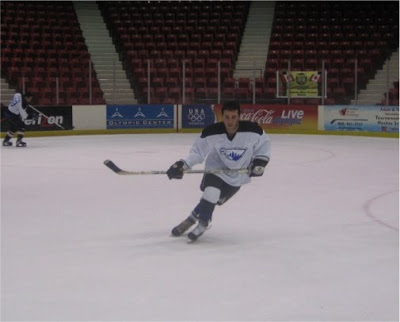 Photo Courtesy: Jon Rosen (taken at Herb Brooks Arena in Lake Placid, NY)
Photo Courtesy: Jon Rosen (taken at Herb Brooks Arena in Lake Placid, NY)
One memory of his youth hockey experience that sticks out in Jon’s mind centers around one practice at the old Iceoplex in Van Nuys that turned into an amazing lesson at the hands of a player from the team he grew up idolizing. The Los Angeles Kings also practiced at the Iceoplex and sometimes, the Kings’ and Jon’s team’s schedules overlapped a little, as happened on this one particular day.
“One of the Kings stayed after his own practice and came onto the ice and worked with us and taught us how to take slapshots and taught us how to skate quicker backwards and was there really to just goof around with the kids and just have fun with us. That man was actually Dan Bylsma, who is now the head coach of the (newly crowned Stanley Cup Champions) Pittsburgh Penguins. He was absolutely the most accessible King and one of the friendliest and one of the best LA Kings I can ever remember wearing that jersey.”
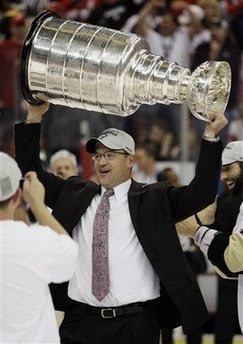 Dan Bylsma/Pittsburgh Penguins
Dan Bylsma/Pittsburgh Penguins
In addition to doing radio play by play for all Everett Silvertips games and spearheading the team’s media and community relations, Jon still plays hockey in an adult league based in Everett. And from what I hear, he’s still pretty good on the ice!
So… we’ve heard from a player who moved up quickly through the youth hockey ranks at high skill levels and is well on the road to an NHL career. And we’ve heard from a former player who still uses the mental and physical skills he learned playing hockey in his everyday life. Now, it’s time to hear from a young lady who’s tearing up the ice as part of the Seattle Junior Hockey Association.
Nat Zieroth has been playing hockey for 3 years. In addition to hockey, she takes ice skating lessons. But the first thing she learned had nothing to do with how to move on the ice.
“The first thing they taught us to do was to get up in hockey gear,” she said. “There’s a different way to get up in hockey gear than regular skating. It’s easier when you fall down sometimes on your stomach because you stand up better. It’s a lot easier when you fall on your stomach.”
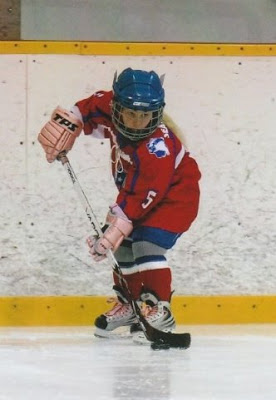 Nat Zieroth/Photo Courtesy: Scott Berg
Nat Zieroth/Photo Courtesy: Scott Berg
The 8 year old likes to play goalie and defense. As we talked, I learned that her game preparation is different, depending on which position she’s playing that day.
As a defenseman: “We get dressed and we have this time that the coach talks to us and then we have time to think about the game. Then we do warm ups, then we start the game.”
As a goalie: “You have to put a lot more gear on and you have to focus a little more than all the other players and you have to work harder than everybody else.”
 Nat Zieroth/Photo Courtesy: Scott Berg
Nat Zieroth/Photo Courtesy: Scott Berg
Nat likes everything about goaltending. She says her best move is her glove save, although she also uses the butterfly technique quite a bit. She can use her stick too, but says most goals come a little high so she relies on her reflexes and her glove. She enjoys playing defense because that position helps out the goalie.
Like the other players we’ve heard from, Nat’s schedule is pretty jam-packed as she fits in practice and games, along with school and homework. At the beginning of the season, practices usually fall on Sundays and Mondays. As the year progresses, practice moves to Wednesday to Sunday, with games on Saturdays. Their mornings start bright and early at 4am during the week, 5am on weekends.
“Thursday mornings I go to stick and puck before school. We have to get up early so I can skate a bit. We have a lot of things going on. Mondays we have a lot of homework (practice book page and cursive). Wednesdays we have math and reading to do.”
 Nat Zieroth/Photo Courtesy: Scott Berg
Nat Zieroth/Photo Courtesy: Scott Berg
But Nat has a deal with her mom Natasha. In order to play hockey, she must have her homework completed by the time Mom comes to pick her up from extended care.
Natasha Zieroth is a single mom who works full time. But she has found a way to make sure Nat gets to all of her practices and games. And she is always encouraging her daughter to focus, try hard, and most of all, enjoy herself on the ice. Natasha offers up some advice to parents thinking about signing their kids up for hockey but aren’t too sure whether to make such a big commitment.
“There are so many options out there,” Natasha says. “Learn to Play programs are relatively inexpensive in the scheme of things. Seattle Junior (Hockey Association) has a rental program where you can rent all the gear for the younger kids for about $75 for the year, which is great because you don’t have to invest so much money up front. ”
She also likes how Seattle Junior handles the beginner classes, which take place with kids on the ice and parents behind a glass partition.
“They took the kids and put them out on the ice and shut the door. In some ways as a parent that’s wonderful because you’re not the sideline coach that’s yelling and screaming.”
But Natasha remembers worrying about her daughter. “She spent the whole hour standing for two seconds then falling on her face. I honestly thought when the hour was up she was going to be like, ‘That’s it, I never want to do this again.’ And she came off and said, ‘When can I do it again?'”
One thing that beginner classes do is get kids into hockey gear before taking them out on the ice. So, not only are the youngsters learning to skate with all the extra gear, it doesn’t hurt as much when they do fall down.
In addition to extra ice skating lessons, Natasha makes sure Nat gets to take part in community or public skating sessions with her friends. The public skates let kids hang out with their friends, while getting in a skating workout at the same time. It just doesn’t feel like a workout.
Natasha confirms that hockey parents are a close-knit community. They become very close during those long hours they spend at rinks, either with practice or traveling to and from games. But she urges any parent who wants to know more about what it takes to have a young hockey player in the family to just come up and start a conversation. Most hockey parents are very friendly and willing to share whatever information or advice they can give. But if you want the answer to the most important question about youth hockey, you have to go to the source, the players themselves.
When I asked Nat what she likes best about hockey, she doesn’t hesitate. “The best thing I like about hockey is that it doesn’t matter if you win or lose. It just matters that you had fun.”
I think she wraps it up pretty perfectly there.
If you’re interested in learning more about youth hockey programs around Western Washington, just click on the links below. They’ll take you to the home pages of the organizations around the greater Everett-Seattle-Tacoma area.
If you’re a hockey player or parent and would like to share your own experience, leave a comment. I’d love to share your stories, too.
Please also email me if you don’t find your hockey association in the list below. I’ll be happy to add it.
Youth Hockey Organizations
Seattle Junior Hockey Association: http://www.sjha.com/
Sno-King Amateur Hockey Association: http://www.snokinghockey.com/
Highland Ice Arena, Shoreline: www.highlandice.com/hockey.htm
Everett Youth Hockey League: www.comcastarenaeverett.com/IceRink/Hockey/everettyouthhockey.ashx?p=83
Kent Valley Hockey Association: www.kentvalleyhockey.com/
North Puget Sound Hockey League: http://npshl.com/
Tacoma Hockey Club:
www.rinktime.com/skating_rinks/wa/tacoma_hockey_club_skating_rink_arena_tacoma_wa.cfm
Whatcom County Amateur Hockey Association:
www.whatcomhockey.com/page.php?page_id=2079
Kitsap County Hockey Association:
www.bremertonicearena.com/youthhockey.html

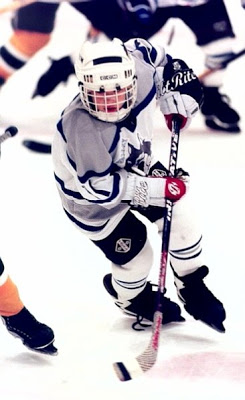
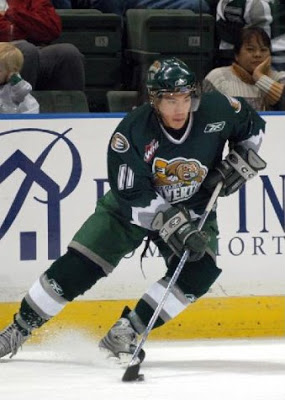
Recent Comments